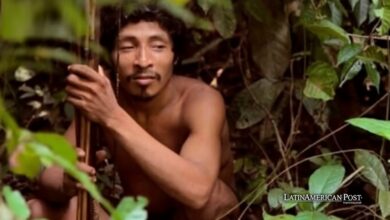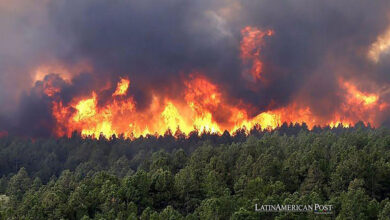How Many Indigenous Peoples In Isolation Are There In The World?
With the death of the so-called Indian of the Hole, an indigenous tribe in Brazil has disappeared. The man lived in isolation for more than 25 years. In the world, there are about 100 peoples who have decided to remain without contact with the rest of the world

Photo: Survival.es
LatinAmerican Post | María Fernanda Ramírez Ramos
Listen to this article
Leer en español: Pueblos indígenas en aislamiento ¿cuántos hay en el mundo y cuál es su situación?
On August 23, the body of a man known as the Indian of the hole was found dead. He was an indigenous person, inhabiting the Brazilian Amazon, in the indigenous territory of Tanaru, who had decided to remain in voluntary isolation, after the murder of the other members of his community, an ethnic group unknown today. The report delivered by the Brazilian police indicates that the death occurred due to natural causes. This person was monitored and protected by the Guaporé Ethno-environmental Protection Front, in coordination with the National Foundation of the Brazilian Indian (FUNAI), for 26 years.
According to this foundation of the Government of Brazil, "The term "isolated indigenous peoples" refers specifically to indigenous groups without permanent relations with national societies or with infrequent interaction, either with non-indigenous or with other indigenous peoples." The decision of these peoples to isolate themselves can be given for different reasons. The most frequent is due to negative encounters with the rest of society that threaten their lives and customs.
100 indigenous peoples in isolation in the world
Brazil is not the only country that has tribes in isolation. Although it is true that most of these are found in South America, there are also many others in Asia. "There are more than 100 uncontacted indigenous peoples throughout the world, from the Amazon to Indonesia, from the Indian Ocean to the Chaco forest in Paraguay," says the Survival organization, dedicated to working for the promotion of indigenous rights. . In Latin America these peoples are found in Brazil, Bolivia, Ecuador, Colombia, Ecuador, Paraguay and Peru.
The Inter-American Commission on Human Rights classifies indigenous peoples in isolation into two groups. In the first place, there are the indigenous peoples in voluntary isolation, these are peoples who do not maintain sustained contact with people outside their people or non-indigenous people. They may have had intermittent contact with the rest of the population at some point and then decided to remain isolated.
On the other hand, there are the indigenous peoples in initial contact, that is, they maintain intermittent or sporadic relations with the non-indigenous population. They may have belonged to the first group, but for some reason, have found it necessary to maintain greater contact with other populations.
Destruction of the environment, destruction of your life
The situation of these people is not simple. Despite the fact that the states must guarantee their protection, many of them suffer constant threats, especially from those who want to occupy their territories to obtain natural resources. Regarding this, in 2013, the United Nations special rapporteur for indigenous peoples, James Anaya, pointed out that: “the principle of no contact must be respected, which implies implementing a public policy that protects their vital spaces and preserves them. of pressure from extractive companies, illegal logging, and unauthorized settlement in the area.”
However, since then the situation does not seem to have improved. Judicial systems, the notion of "development" and the way of organizing societies have a Western origin that these peoples are unaware of and that is not always the most suitable in their context. For this reason, it is necessary for there to be an intercultural dialogue that reconciles indigenous justice with the ordinary justice of the States and values their role as protectors of ecosystems and repositories of knowledge, especially in relation to the protection of territories.
We suggest you read: Indigenous Peoples Must Be Leaders In Conservation And Sustainability
The 2019 regional report on indigenous peoples in isolation, carried out by the Land is Life organization in conjunction with other organizations, indicates that there are constant violations of the rights of these peoples. The absence of states and extractivist policies worsen the situation. In said report, Victoria Tauli-Corpuz, Special Rapporteur on indigenous peoples of the United Nations, points out that: "In addition to the existence of illegal activities on the lands and territories of indigenous peoples in isolation, it is of special concern that these intrusions are a result of activities supported by the States themselves. They continue to grant extraction licenses and plan the construction of infrastructures that directly affect their territories, livelihoods, health, migration patterns and, consequently, their survival".
The Survival organization constantly denounces the attacks of which many of these peoples are victims. Mass murders are usually committed to drive them off their land.
Currently, one of the most delicate situations is experienced in Brazil. The current president of FUNAI, Marcelo Augusto Xavier da Silva, has been accused of having anti-indigenous policies. An investigation by Human Right Watch denounces the atrocities that the Brazilian government is committing. "The administration of President Jair Bolsonaro has undermined the government agency charged with protecting those rights, issued regulations that are detrimental to indigenous peoples, and stopped recognition of their traditional lands," it says.
However, their situation is not better in other territories. Paraguay, Venezuela or Peru also have towns that are being threatened. For its part, the Inter-American Commission on Human Rights points out that: "in the analysis of the human rights situation of indigenous peoples in voluntary isolation and initial contact, it is essential to bear in mind how devastating the destruction of a plantation can be for them. , the contamination of a river, the deforestation of a forest, and other effects on the environment in which they live and on which they depend.




